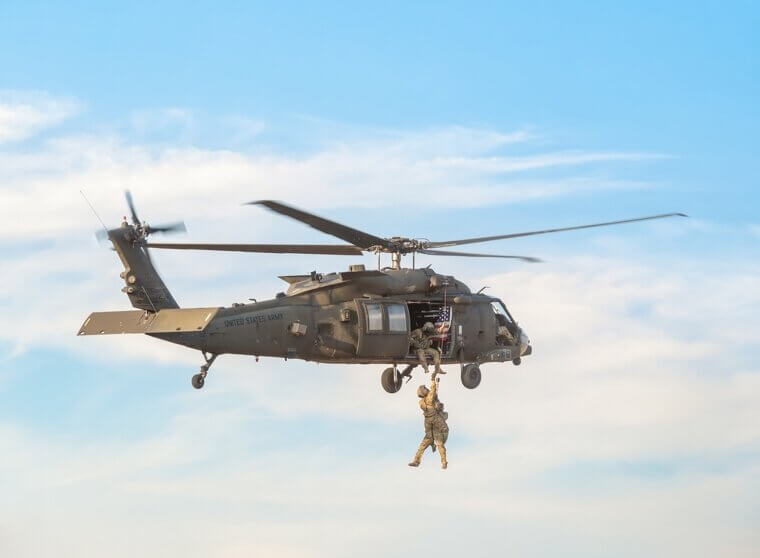The United States Armed Forces is a huge organization, and you only need to look at the country's military budget to get a sense of how large it is. There are six different branches, all of which have different missions and even, in some cases, different ranks for those who serve. However, salaries are generally pretty consistent and depend on things like rank, specialties, and experience. Here are all of the salaries of enlisted personnel and commissioned officers from the lowest rank all the way up to general.
Enlisted Members Receive Around $420.14 Per Month For Groceries
We'll start out with the basic allowances given to both enlisted and officers. These allowances are just meant to cover things like food and groceries, so they're generally pretty small. Enlisted personnel receive around $420 a month to spend on groceries and food. On the other hand, officers get around $266.18 a month, but their salaries are generally a bit higher than enlisted, depending on things like experience and rank.
Neither sum is going to make much of a dent in monthly expenditures, but it's still a nice little paycheck that can help out with something personnel would already be spending money on.
Cadets And Midshipmen Get Around $1,186 A Month
It might not seem like much, but $1,186 per month isn't too bad when you consider that cadets and midshipmen are just students attending an academy. It's basically sort of like being a college student and being paid to attend university. Factor into that students stay on campus and have free lodging, and it starts to sound like it is not such a bad deal, especially compared to more traditional colleges.
After they graduate, cadets and midshipmen become commissioned officers and usually bring in a salary that's higher than someone who's just been enlisted with the same amount of experience.
E-1 Enlisted Receive Around $1,650 A Month
If you've just enlisted, then you can usually expect to earn around $1,650 a month starting out. These E-1s are called privates if you're talking about the Army or the Marine Corps. In the Air Force and Space Force, they're called Airman Basics, while the Navy and Coast Guard refer to them as Seamen Recruits. No matter their name, they all receive around the same amount of money per month.
Not everyone starts out as an E-1, but you usually need to have a degree, placed pretty high during testing, or have some other set of skills that set you apart from others.
E-2s Get Around $2,000.70 A Month
After getting promoted from an E-1, your salary gets a bit of a bump, and you start earning around $2,000.70 a month. The average time it takes to get from an E-1 to an E-2 is around nine months, or right after you get out of basic. The name of this rank depends on what branch you've joined, with the Army referring to their E-2s as private second class and the Marines calling it private first class.
If you've joined the Air Force or Space Force, you're an airman, while the Navy and Coast Guard refer to their E-2s as seaman apprentices. However, they all earn around the same pay.
E-3s With Under Three Years Experience Receive $2,103.90 Per Month
This is where experience starts to play a bit more of a role in the pay scale since it's possible to stay at one of these ranks for more than a year or two. E-3s who have less than three years of experience get $2,103.90 a month, while those with more years of experience get a small bump to $2,371.80. These are lance corporals in the Marines and private first classes in the Army.
In the Coast Guard and Navy, E-3s finally become seaman, while the Air Force and Space refer to them as airman first class. It takes most about a year and a half to get to an E-3.
E-4s Receive Around $2,330.40 A Month
The salary gap widens a lot more for E-4s with or without years of experience. For those with less than two years of experience, they receive $2,330.40 a month. Service members with more years of experience can make as much as $2,829 a month. In the Air Force and Space Forces, these can be senior airmen, while in the Marines, they're usually still corporals. They can be specialists or corporals in the Army.
The Navy and Coast Guard call them petty officers, third class. This one depends a bit more on the branch, but the average time it takes to reach E-4 is around two to three years.
E-5s Make Around $2,541.60 A Month
It takes some dedication to make it all the way to an E-5, and your salary starts to reflect that. To make an E-5, you have to have been enlisted for at least two years, depending on the branch, but it usually takes most people longer to make the rank. Both the Air Force and Space Force refer to their E-5s as staff sergeants, while the Marines and Army simply call them sergeants.
They're petty officers in both the Navy and Air Force. If you've been in the service for a bit longer than most, then you can expect to earn around $3,606.90 a month.
E-6s Are Paid $2,774.40 A Month
If you've made it to an E-6, then you're probably doing something right. These would be your staff sergeants in both the Army and the Marine Corps. They're petty officers in the Coast Guard and Navy, and the Air Force and Space Force call them technical sergeants. The starting pay for an E-6 is around $2,774.40 a month, but that can rise to as much as $4,297.20 if you have more experience.
The time it takes for most to reach an E-6 really depends on a couple of different things, such as the branch they're serving in, but it can take an average of sixe to eight years for most.
E-7s Earn Anywhere From $3,207.60 To $5,765.40 Per Month
An E-7 is toward the top of the scale for enlisted. They make anywhere from $3,207.60 to $5,765.40 a month, depending on how many years they've been in the service. These are your gunnery sergeants if you're in the Marines and sergeant first classes if you're in the Army. In the Coast Guard and Navy, they're called petty officers, while the Space Force and the Air Force call them master sergeants.
Like some of the other pay grades at the higher end of the scale, the average time it takes to reach E-7 varies wildly depending on the branch. It can take anywhere from 8 to 17 years to reach E-7 on average.
E-8s Receive $4,614.60 To $6,581.40 A Month
Achieving E-8 is so hard that only around 2% of the Air Force is ever allowed to be an E-8. They can typically expect to make around $4,614.60 to $6,581.40 per month, depending on their years in service. They're senior chief petty officers in the Coast Guard and Navy, while the Air Force and Space Force call them senior master sergeants. In the army, they're referred to as either master sergeant or first sergeant.
The Marines call them just master sergeants. It usually takes years to reach this rank, and the average age of an E-8 in the army is around 35 years old.
E-9s Pull In Anywhere From $5,637 To $8,752.50 A Month
An E-9 is the highest non-commissioned rank in each of the branches, and it's extremely hard to achieve. A single E-9 from each branch is chosen to act as a sort of head of enlisted personnel for that branch. They make around $5,637 To $8,752.50 a month depending on the amount of time they've been in the service, and they make up just 1% of the members of each service.
There are a couple of different ranks listed under E-9, but generally, they're your master chief petty officers in the Navy and Coast Guard, master gunnery sergeants and master sergeants in the Marines, sergeant majors in the Army, and chief master sergeants in the Air and Space Forces.
Air Traffic Controllers Make Around $97,360 A Year
This next section is dedicated to specialty jobs that can often vary widely in pay despite rank. For example, air traffic controllers can be just about any enlisted rank, but they can make as much as $97,360 a year to make sure that all of the military's aircraft are being deployed quickly and efficiently. They also make sure that airfields and ground centers are running smoothly, which is a huge responsibility.
In all the branches of the military, there are about 9,112 people working this job in all parts of the globe and both on land and at sea.
Supply And Warehouse Managers Make $98,878 A Year
It might not sound like the most glamorous job in the military, but it's one of the most important jobs in the military. Supply and warehouse managers pretty much do exactly what their title sounds like, but that's a huge task for a military as large as the one the United States has, especially when so much focus is placed on logistics. Managers have to make sure things get to where they're going quickly.
They also have to account for inventory, future needs, and a whole bunch of other stuff that requires excellent organizational skills. There are currently around 14,982 supply and warehouse managers serving.
Training Specialists Make Around $124,193 A Year
There are a number of different specialties service members can receive training in after completing their basic training and the people who come up with the courses and curriculum for those specialties are called training specialists. They're paid around $124,193, and they make sure that the troops who take the classes are well-versed in everything from explosives to tactics. There aren't many of them though, with only around 228 specialists serving.
You also have to have a college degree in order to be a training specialist since it basically requires you to be a teacher yourself and be extremely knowledgeable about your subject.
Pharmacists Make Around $137,992 Per Year
The military has doctors, so it only makes sense that it also has a number of pharmacists serving in its ranks. There are around 676 pharmacists in the military, and they basically do everything that a civilian pharmacist does, which includes making sure service members receive the correct medicine they need and at the right dosages. They also have to be extremely knowledgeable about all of the medicine they're giving out.
Pharmacists in the military make around $137,992 a year, which isn't bad at all, but it does require a bit of studying in order to become a pharmacist, just like in the civilian world.
Epidemiologists And Infectious Disease Physicians Make $117,456 A Year
Epidemiologists and infectious disease physicians are doctors and officers who work on figuring out everything there is to know about infectious diseases. They're also on the front lines when the military is called in to help a civilian population with a pandemic or some kind of outbreak. That's in addition to handling cases of biological warfare, so it's a job with a ton of responsibility that's reflected in the pay.
These doctors make around $117,456 a year plus benefits and a pretty generous signing bonus. There are around 1,487 serving in the military today across all of the branches.
Chaplains Make Around $118,154 A Year
Chaplains hold a really unique position in the U.S. military. For starters, they usually hold a master's degree of some kind in theology, and they're technically officers. However, they don't have the authority to command troops due to the country's separation of church and state. Still, they're viewed as the spiritual leaders of the units they serve in, and they can provide counseling if someone in the unit asks for it.
They make around $118,154 a year. There are around 3,000 chaplains serving, and they come from all different kinds of religious backgrounds to reflect the diversity of the military.
Physicists Make $130,580 Per Year
At any point in time, the military is conducting all kinds of scientific experiments throughout all the branches, so it only makes sense that it would employ a number of physicists to conduct a lot of those experiments. There are around 437 physicists currently employed by the military, and they make around $130,580 a year on average. Of course, they have to have years of education in order to serve as physicist.
Many are leading scientists in their fields, and they get to work on projects that are years ahead of a lot of things you'd see working in the civilian sector.
Computer Programmers And Developers Make $118,839 Per Year
Technology is a huge component of the modern military, which is why they employ around 1,226 programmers and developers to create systems and write code. They're paid around $118,839 a year. A lot of the systems that they develop are custom-made for the military, and they're made to be used on anything from an iPad to a fighter jet. They also work across all of the different branches of the military.
You usually need a degree in order to serve as a programmer or developer, but you can join as either an enlisted or as an officer in whatever branch you choose.
Social Workers Earn $120,752 A Year
Social workers in the military perform a lot of the same tasks as social workers in the civilian world, but where they perform those tasks usually differs. Military social workers usually work with other military personnel and their families. However, they're also called upon when the military is responding to a disaster of some kind. The average social worker in the military earns around $120,752 a year, depending on experience.
There are only around 290 social workers serving in the military, and they must join as officers since there are a lot of education requirements to being a social worker.
Music Composers And Arrangers Make $126,026 A Year
Music composers and arrangers aren't just the people who perform in military bands. They have the honor of actually creating original music for the military. As such, there are only around 27 of them across all of the branches, and they make an average of $126,026 per year. It requires a lot of knowledge about music and the history of music in the military, and it also takes a lot of dedication.
Composers and arrangers perform and work during some of the most prestigious events in the military, including ceremonies when foreign leaders and ambassadors are welcomed to the United States.
Chemists Are Paid $124,495 A Year On Average
Chemists have the immense responsibility of conducting studies that aid in protecting personnel and civilians from things like biological and chemical weapons. They make around $124,495 a year, and there are only 68 of them in the entire military, spread across all of the branches. Since there are so few of them, they're often in charge of their own studies and are responsible for organizing everything associated with their experiments.
Like other scientific fields in the military, a chemist has to undergo years of education and study before they join they're allowed to start their own work with the military.
Dental Laboratory Technicians Make $158,901 A Year
Dental laboratory technicians are among the most well-compensated in the military because there are so few of them. The military only employs about 70 of them in total, and they do everything their counterparts in the civilian world do, including working on things like dentures and crowns. They typically make around $158,901 a year, and they can be found in all of the branches, working both on land and at sea.
Their pay can vary depending on how long they've served in the military and where they're stationed. For example, if they're stationed aboard a ship, their pay may be more.
Nuclear Engineers Make $116,097 Per Year
Nuclear engineers have one of the most important jobs in the military, and there are actually quite a few of them serving. There are around 726 service members who work as nuclear engineers, and they do things like make sure the nuclear reactors on board submarines and aircraft carriers are working as they should. They're also responsible for fixing them in case something goes wrong, which is a very big responsibility.
They usually make around $116,097, although that number can vary by quite a bit, depending on where they're serving and what tasks they're expected to do while there.
Military Judges Make $114,779 Per Year
You don't often think about judges when you think about the military, but there's an entire special judicial system set up for military law. Judges are responsible for hearing cases involving court martials and other proceedings related to internal military affairs. Because of this, they have to be highly specialized in military law and have years of experience, sometimes practicing as a military prosecutor or defender. There are around 1,671 of them serving.
However, the job is probably even harder to get than a appointment as a civilian judge due to the years of experience working specifically in the military that's needed.
Helicopter Pilots Earn $77,487 A Year
It takes a lot of training to become a helicopter pilot in the military. They're often charged with performing high-risk maneuvers close to enemy combatants and close to the ground, and they can often prove decisive in the conflict. Because of this, they earn $77,487 a year on average, and they either have to join as an officer or serve as an enlisted service member before they can get into flight school.
Every branch of the U.S. military has helicopter pilots serving in it, and there are around 1,068 pilots for some 5,500 helicopters that were in service as of last year.
Podiatrists Make $113,428 A Year
At first, it might seem surprising that the military employs podiatrists, until you consider that the feet and surrounding areas are often some of the most beaten up in the military. Soldiers have to walk or run long distances carrying heavy packs, and all of that can take a toll on their bodies. Podiatrists deal with sprained ankles, broken bones, soreness, and a whole host of other issues affecting service personnel.
Podiatrists are paid around $113,428 a year, and they're probably some of the most important medical personnel in the military when it comes to day-to-day issues affecting soldiers.
Healthcare Administrators Earn $110,826 Per Year
The military has thousands of people working in healthcare fields, and they all need to be organized by healthcare administrators, who make some $110,826 per year. Administrators are responsible for everything from hospitals to smaller clinics, and they're everywhere in the military, working across all six branches, making sure that personnel are getting the care that they need. There are around 3,591 of them in total, both at bases on land and on ships.
Administrators can only achieve that title as an officer, and they have to have completed or be in college and working towards a four-year degree of some kind.
Human Resource Managers Earn $84,121
Another really important job, human resource managers in the military have a lot on their plate. They're in charge of both the good and the bad, and they're responsible for making sure that service men and women are awarded when they perform well, or that they're disciplined when they mess up. The job pays around $84,121 per year on average with that number varying depending on the amount of time someone has served.
In an organization where rules are as important as they are in the military, human resources have a lot of responsibility in making sure that everyone is acting as they should.
Recruiters Are Paid $79,773 A Year
Military recruiters are responsible for making sure that all of the branches of the military are meeting their recruitment targets and that there's a steady stream of new applicants signing up to join the military. You've probably seen them visiting high schools to sign people up and gauge interest or attending job fairs to tell people about opportunities in the military. Most of them make around $79,773 a year, but that number can vary with bonuses.
Those who serve as recruiters come from whatever branch they're representing and they've typically been serving for a while before becoming a recruiter, so they're pretty familiar with the whole process.
Artillery And Missile Officers Earn $79,188 A Year
Artillery and missile officers have one of the most important jobs on the battlefield. They're basically in charge of directing artillery crews. That means that they need to have crews ready to fire, reload, and fire again, all within a very short time frame. They also have to know where to direct fire in order to avoid hitting fellow soldiers and ensure effective fire. All of this has to be done in a highly stressful environment.
Because the U.S. has so much artillery, there are around 28,297 artillery and missile officers in the Armed Forces, serving in all of the branches and making around $79,188 a year.
W-1s Make Anywhere From $3,309.30 To $5,718.60 A Month
This next section is devoted to warrant officers, who are situated between enlisted personnel and commissioned officers. They're basically enlisted who've been made officers due to their specialization or expertise in a certain field. W-1s are the lowest-ranked warrant officers, but they still make anywhere from $3,309.30 to $5,718.60 depending on their expertise and the amount of time they've served in the military. The only branches without W-1s are the Space and the Air Forces.
To become a warrant officer, your promotion has to be approved through Congress, and you need to be highly knowledgeable in your field. Only then can you apply to attend the Warrant Officer Candidate School.
W-2s Make $3,770.40 To $6,293.10 A Month
The pay scale for W-2s is really dependent on how much experience someone has in the military. They can make anywhere from $3,770.40 to $6,293.10 per month, which means they can double their salary if they've served long enough. In every branch but the Air Force and Space Force, they're called chief warrant officers, and like W-1s, they have to be extremely knowledgeable about whatever specialization they have to make W-2.
Unlike W-1s, chief warrant officers are actually commissioned by the president, although they still rank under most regular commissioned officers when it comes to the chain of command.
W-3s Make $4,261.20 To $7,474.50 A Month
A W-3 is also referred to as a chief warrant officer, but they've had their pay bumped up a bit, and they're considered "advanced" in their specialization or field. They also usually assist others through the brigade level instead of the battalion level. Some examples of warrant officers include helicopter pilots who are automatically promoted to W-1 when they finish up with their pilot's school. They take the same oath as commissioned officers.
It can take an enlisted service member years to make W-3 since they have to already have made at least E-6 in addition to being an expert in their field.
W-4s Make $4,665.90 To $8,691 A Month
A W-4 is one of the highest levels an enlisted service member can achieve, and it comes with a nice bump in salary. Those serving as a W-4 can make anywhere from $55,990.80 to $104,292 a year, depending on how long they've been in the military. The only branches that do not have warrant officers at all are the Space Force and the Air Force, although both of them have indicated that may change in the future.
For now, you can only achieve W-4 in the Marines, Army, Coast Guard, or Navy, and you usually have to spend a lot of years trying to climb this high in rank.
W-5s Make $8,296.20 To $10,856.40 A Month
This is the highest level of warrant officer that an enlisted soldier can get to. W-5s make around $8,296.20 to $10,856.40 a month, which ends up being $99,554.40 to $130,276.80 a year, depending on experience. Either way, it's a massive pay boost over most of the other enlisted ranks, and it's right up there with a lot of specialties and officer ranks. W-5s are highly respected for their knowledge and special responsibilities.
However, it's extremely hard to achieve, and they make up about 5% of all warrant officers in the Armed Forces, so not everyone will be able to achieve W-5 during their military career.
O-1s Earn $3,385.80 To $4,260.60 A Month
Now, it's time for the pay grades that make up the commissioned officer ranks. Starting off is O-1, which is basically someone who just graduated from the academy. At this level, there are some enlisted soldiers who outrank them due to their inexperience. However, they still make good money, bringing in anywhere from $3,385.80 to $4,260.60 a month. It usually takes around four years to graduate from an academy.
After graduation, they usually become either second lieutenants or ensigns, and they're already off to a good start when it comes to the amount of money they're making compared to other recent graduates.
O-1Es Make Around $4,260.60 To $5,289.90 A Month
Any officer with an "E" at the end of their rank has spent some time serving as an enlisted member of the military. O-1Es are those who've served for at least four years before becoming commissioned officers in the military. They usually make anywhere from $4,260.60 to $5,289.90, depending on just how long they've been serving. While they're still technically at the same pay grade as newly commissioned officers, they do make a bit more.
That's because they already have years of military service and experience compared to officers who've only gone to an academy and don't have any prior experience in the military.
O-2s Typically Make $3,901.20 To $5,398.50 Per Month
This one is really simple in that you're automatically guaranteed your O-2 if you've served for 18 months. O-2s are called first lieutenants in the Army, Marines, and Air Force, while the Coast Guard and Navy refer to them as lieutenant junior grades. However, they usually make around $3,901.20 to $5,398.50 a month or $46,814.40 to $64,782 a year. O-2s are still relatively inexperienced compared to a lot of other ranks.
At O-2, you start to lead around 60 others in squads, and your responsibilities begin to increase. You're also no longer considered a fresh recruit and pay reflects that.
O-2Es Earn $5,289.90 To $6,251.70 Per Month
An O-2E is a formerly enlisted soldier who's transferred to being an officer. They make more than their purely commissioned officer counterparts due to their experience, and they have to have served for at least four years as an enlisted member of the military. Similar to O-1Es and O-1s, this pay grade grants is a bit more prestigious due to the years of experience it takes to become an O-2E.
You can also become a commissioned officer if you formerly served as a warrant officer, and it's not uncommon for many to take that route since it offers more potential for advancements.
O-3s Earn Around $4,514.70 To $7,345.20 A Month
The next pay grade for an officer is O-3, which is always classified as captain in all the branches but in the Navy and Coast Guard. In those two branches, they're called lieutenants. An officer at this rank can expect to earn around $4,514.70 to $7,345.20 a month. Officers have a couple of different options when they reach this rank, including commanding up to 190 other service members in the field.
They can also start serving as instructors or teachers when they reach O-3. The pay here depends on how long they've been in the military, as with other ranks.
O-3Es Get $6,022.80 To $7,839 A Month
This is the last officer designation that gets the "E" at the end, and those who have transferred from enlisted to officer earn around $6,022.80 To $7,839 every month, which is a large jump from just about anything a regular enlisted member can earn. As with similar ranks, you have to have served for at least four years as an enlisted member of the Armed Forces to be able to achieve O-3E.
However, with the huge jump in pay, it's worth it, especially considering you get to experience both sides of the military in being enlisted and eventually becoming an officer.
O-4s Make $5,135.10 To $8,573.70 Per Month
We're getting to the halfway point when it comes to officer ranks, and the next one on the list is O-4. This is where you become a major in most branches but a lieutenant commander in the Navy or the Coast Guard. It's also where you can start earning as much as $8,573.70 if you've already had a few years of experience under your belt before achieving the O-4 rank.
Majors "serve as the primary staff officer for brigade and task force command and manage personnel, logistical, and operational missions," according to the Army. Some are able to achieve this rank quickly, but it's not common at all.
O-5s Make $5,951.40 To $10,111.20 A Month
O-5s can make up to $10,111.20 a month, depending on the number of years they've served, which equals out to around $121,000 a year. It's quite an achievement, and it can sometimes take years to get to an O-5. In all branches but the Navy and Coast Guard, they're referred to as lieutenant colonels. In the other two branches, they're called commanders since the responsibilities somewhat differ out at sea.
Commanders are sometimes heading up around 1,000 service personnel, and they're responsible for a lot of the logistical aspects of a battalion. So, there's a lot of responsibility that comes with this position.
O-6s Earn $7,139.10 To $12,638.40 A Month
Colonels and Captains, depending on the branch you're referring to, make as much as $12,638.40 per month. Colonels are generally responsible for brigades in land-based branches, sometimes commanding as many as 5,000 people, while captains can head up their own ships in the Navy and the Coast Guard. The exact amount of pay depends on how long either has been in the military, but both are well compensated for their service.
The actual time can vary, but most can expect to only be considered for a colonel after around 22 years of being in the military, which takes a lot of commitment.
O-7s Get $9,414.30 To $14,065.80 A Month
This is where you begin to see officers wearing stars. O-7s are called brigade generals in all of the branches, but in the Navy and the Coast Guard, they're referred to as rear admiral lower half. Once you reach a brigadier general, you can earn as much as $14,065.80 a month, but it takes an extraordinary amount of dedication and time, and even then, you're not guaranteed to be promoted to O-7.
Brigadier generals are tasked with overseeing the planning of missions, as well as a list of other tasks that require exceptional organizational and leadership skills in order to run smoothly.
O-8s Earn Anywhere From $11,329.50 To $16,333.20 A Month
O-8s are two-star generals who earn anywhere from $11,329.50 to $16,333.20 a month. They're in charge of divisions, which can number as many as 15,000 soldiers, and they're some of the most important people in the military since their decisions are felt by thousands of people. In all the branches but in the Navy and the Coast Guard, they're called major generals. In both the Navy and Coast Guard, they're called rear admirals.
This is another rank that requires years of service to even be considered for, but very few people are ever actually promoted to the rank of major general or rear admiral.
O-9s Make $16,012.50 To $16,608.30 A Month
O-9s are called lieutenant generals, or in the case of the Navy and Coast Guard, vice admirals. They wear three stars, and they're the second highest rank that you can usually achieve in the military. As such, their salaries reflect this, and they're paid around $192,150 to $199,299.60 a year, but most people in the military will never achieve O-9 since there are so few spots to go around.
To be considered, you have to have spent 20 years in service, but most of the people who actually make O-9 have served for quite a bit longer.
O-10s Earn $16,608.30 Per Month
This is the highest rank that an officer can achieve, and it's also the cap when it comes to the pay scale. O-10s wear four stars on their uniform, and they're referred to as generals and admirals. They're the highest-ranking military officials in their respective branches, and they earn up to $16,608.30 a month. Those who are picked to serve as O-10 have usually been in the military for more than 30 years.
They're also in charge of pretty much all the military operations in the areas where they've been assigned. The only way to attain a fifth star is to command a large coalition, which hasn't been the case since the mid-20th century.

















































